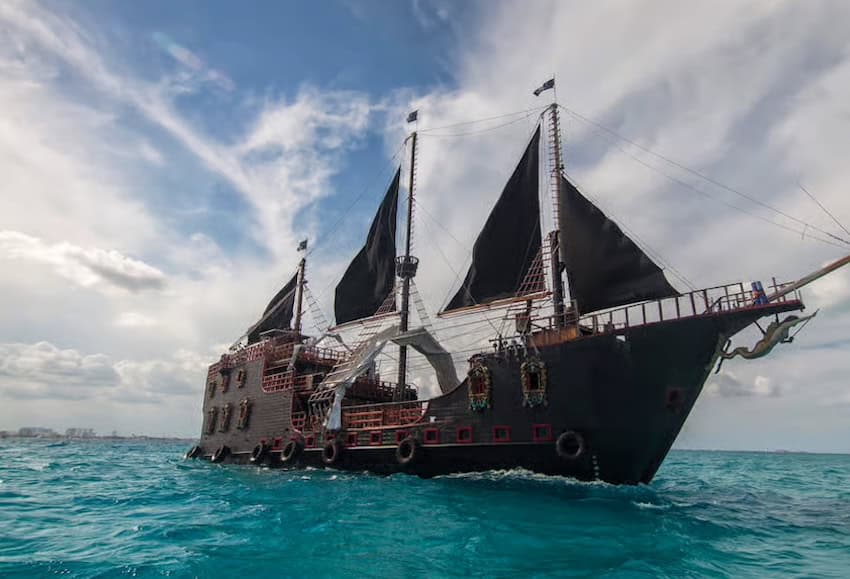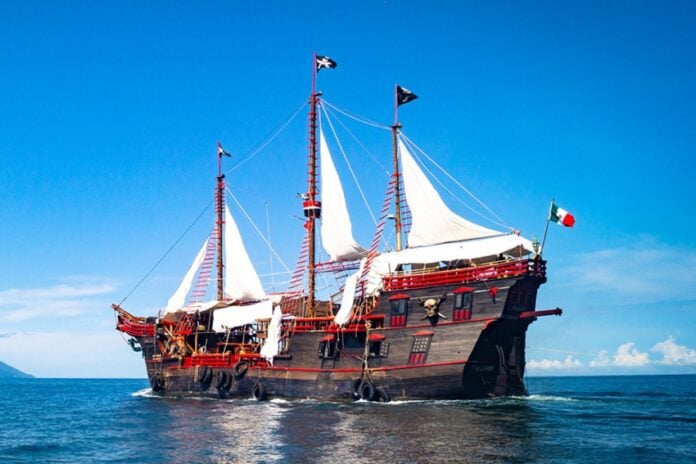For decades, she was a floating spectacle: a roaring, rollicking Vegas-style pirate ship, ablaze with fireworks, sword fights and the ever-flowing promise of all-you-can-drink tequila.
Each night, beneath the warm Mexican twilight, tourists in Puerto Vallarta flocked to her, enchanted by her swashbuckling promises. Music blared, laughter echoed across the Bay, and the Marigalante set sail in a blaze of revelry.
The history of the Marigalante

But behind her dazzling theatrics was a gentler, nobler beginning, one few on board ever knew, as they clinked glasses and cheered on buccaneers wielding plastic cutlasses. The Marigalante wasn’t always a kitschy, tequila-fuelled fantasy. She was born of a far quieter dream.
A full-scale, seaworthy replica of one of the three ships that sailed the Atlantic in 1492, Christopher Columbus’s Santa María, she was lovingly crafted to serve as a floating ambassador of peace, history and cultural dialogue. She wasn’t built for crowds or cocktails, nor for cannon blasts and photo ops. She was conceived as a symbol.
Her tale stretches across oceans and decades. From a forgotten shipyard in Veracruz to the distant ports of the world, from diplomatic mission to floating fiesta, and, finally, to the quiet, final stillness beneath the waves.
The ship’s journey began in Veracruz
The Marigalante’s journey began in the early 1980s, in the bustling port city of Veracruz. At the helm of the vision was Vital Alsar Ramírez, a Spanish-born scientist and sailor who had made Mexico his adopted home. Known for launching epic ocean voyages on humble rafts, Alsar had long been fascinated by the sea’s ability to connect people and cultures. But his ambitions had grown grander. No more rafts. He wanted a galleon.
Thus began the “Mar, Hombre y Paz” Project (Sea, Man and Peace), a maritime mission shaped not by conquest, but by understanding and meaning.
The Marigalante was built using traditional shipbuilding techniques. Her hull was crafted from mahogany and teak, her beams of pine, each timber fitted with care. The aim wasn’t theatrical nostalgia, but historical integrity. She was meant to be a messenger, flying a white flag of peace, sailing not to entertain but to unite.
Crossing oceans like her model

But dreams, like ships, are expensive things. When Mexico’s peso sharply devalued in 1982, the project stalled. The nearly-built Marigalante sat tethered and forgotten for several years, unfinished, uncelebrated and slowly wearing with salt and time.
Eventually, funding returned, construction resumed and the Marigalante was finally completed. And for a brief, shining season, she lived her purpose.
She crossed oceans, docking with fanfare in Spain, parading past crowds in Brazil, gliding through the locks of the Panama Canal and even bowing gently into Japanese harbors. At each port, she offered not conquest but conversation. She was a vessel of diplomacy. She was a floating museum providing a bridge between centuries.
The move to Puerto Vallarta
Yet, noble missions often drift into reality, and maintaining a full-scale wooden galleon, especially one meant to sail internationally, proved more costly and complex than idealism could sustain. The Marigalante was sold to private owners, and her course shifted permanently.
She was brought to Puerto Vallarta, where the sun-soaked tourism industry welcomed her transformation with open arms. And so, a new era of sequins and stage fights began.
She was retrofitted for spectacles. Loudspeakers, fire jugglers, choreographed sword duels and nightly fireworks now filled her decks. Each evening, she would sail into the horizon, her belly full of tourists and her timbers echoing with laughter, music and the clink of cocktail glasses.
The final dramatic chapter

To the thousands who boarded her each year, she was just a really cool pirate ship. But beneath the glitter and smoke, echoes of her old soul remained.
Her name, Marigalante, a lyrical reinterpretation of Maria Galante, an early name for Columbus’ flagship, remained proudly etched on her hull. Her wooden frame still bore the bones of the ship that once sailed for peace. Her essence lingered, if only quietly.
Then, in a twist almost too poetic to believe, her story came full circle on Columbus Day weekend. On October 10, under skies that had once watched her sail in glory, the Marigalante met her final and most dramatic chapter.
The details remain under investigation, but what is known is that she began taking on water. As curious onlookers gathered on the beaches nearby, she listed heavily and struggled for balance. Finally, she surrendered to the sea she’d once ruled.
Miraculously, no one was hurt. But the image of her sinking — majestic and tragic — has left the community reeling. A floating landmark, a familiar friend, was gone.
Replacing the irreplaceable
In the days that followed, there was talk of salvaging and restoring her. But instead, a sister ship is set to take her place: The Jolly Roger, another replica of the Santa María, is being relocated from Cancún and is expected to begin tours by late 2025, if all goes to plan.

Unlike her predecessor, the Jolly Roger was designed from the start for entertainment. She’ll come outfitted with modern amenities and updated attractions, every inch built to dazzle. But whether she’ll inherit the soul of her sunken sister remains to be seen.
The Marigalante’s life raises deeper questions about preservation, the commodification of culture and how we remember the past. She spent her final years as a party boat, yes, but she was born of something far more idealistic.
Built in peace, tied to conquest
In her earliest form, she was a vessel of diplomacy and historical memory. Her later life was a fantasy cruise for honeymooners and spring breakers. Both stories are true, and both are hers. And in the end, the Marigalante was neither fully one nor the other. She was a floating contradiction of a ship, built to heal and one dressed up to entertain.
Even her very model, the Santa María, now carries a new weight. In recent years, Columbus’s legacy has faced renewed scrutiny, as historians and communities reckon with the devastating impact of his voyages on Indigenous peoples across the Americas.
The Marigalante was conceived with peace in mind, yet symbolically tied to conquest. Her creation was noble, but her associations were complex. In the shifting tides of historical understanding, her story now feels both poignant and painfully relevant.
Charlotte Smith is a writer and journalist based in Mexico. Her work focuses on travel, politics, and community. You can follow along with her travel stories at www.salsaandserendipity.com.
